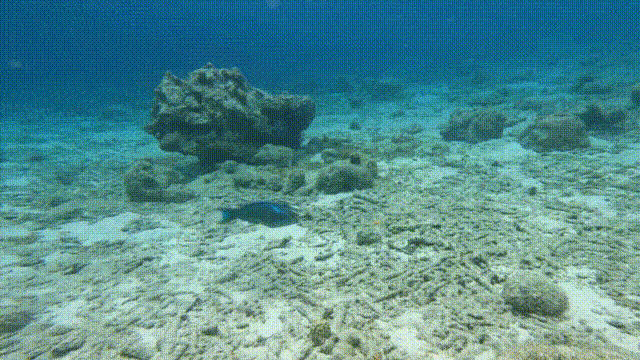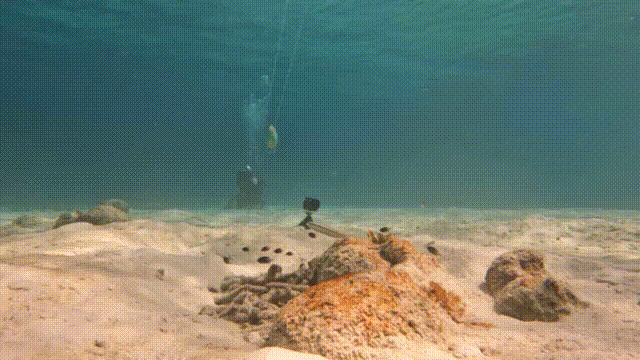When your body is shaped like a scallion, you can get away with a lot. Despite growing up to three feet long, a trumpetfish is hard to spot amid the chaotic splendor of a coral reef. This stealth is ideal for a trumpetfish and bad news for its prey, the smaller fish and invertebrates hoovered into its flared mouth. Sometimes, trumpetfish will hover upside-down in an aquatic equivalent of a handstand until a meal swims by below. But trumpetfish have another strategy to conceal themselves from their prey, a strategy that is so deceptively simple that it probably doesn't even really count as camouflage: hiding behind a bigger, less-threatening fish.
The twig-like trumpetfish swims alongside its host, which might be a large fish like a parrotfish, an herbivore that poses no threat to the trumpetfish's fishy prey, or sometimes a whole shoal of sergeant majors or goatfish. This shadowing behavior has been observed by divers throughout the Caribbean. Coral reef ecologists "have long suspected that this enables them to 'sneak up' on prey," Paul Sikkel, a marine ecologist at the University of Miami who was not involved with the research, wrote in an email.

Sam Matchette, a marine behavioral ecologist at the University of Cambridge, read about shadowing in countless guidebooks and dive blogs. "We were just absolutely taken by this idea that they could be using other animals for concealment," he said. "But no one had tested it. We thought, well, let's do it. Let's be those people." Their test, which hinged on hand-painted fish puppets, was published this week in the journal Current Biology.
Matchette knew he wanted to test this hypothesis in the field, where fish are more likely to do their regular thing. The fish in question were the trumpetfish's usual prey—small bicolor damselfish that school around specific structures in coral reefs that offer shelter. The researchers would simulate a trumpetfish swimming over a damselfish colony, then a parrotfish, and then the two together, by dragging models of the fish along a nylon pulley.

They printed 3D models of the fish, hollowed out and weighted. And then, to ensure the damselfish would be duped, a flourish of artistry. "I did feel a sort of Bob Ross moment coming on," Matchette said. "I was just sat in my conservatory at home painting fish as realistically as possible." Matchette painted the fish models for several weeks, using slight variations in colors and patterns drawn from guidebooks. The trumpetfish's coloration was less complex, but the stoplight parrotfish required an electric array of colors, straight off of a disposable Jazz cup.
In March 2022, Matchette and colleagues arrived in Curaçao to fool some fish. But when they tested the painted fish in a sand flat, the puppets refused to cooperate. The models were supposed to be neutrally buoyant to mimic living fish, but for the first week the models switched between bobbing along the surface or dive-bombing into the sand. "Under the water you can't curse or anything because no one can hear you," he said. "So I was just very angrily gesticulating towards myself and my dive buddy Chris," he said, referring to his co-author Christian Drerup, a graduate student at Cambridge. The researchers ended up having to break apart Matchette's meticulously painted models and drill holes to flood the inner body.
Once the model was fixed, the researchers scouted the reefs for sizeable damselfish colonies, which often clustered around firecracker corals or gorgonian corals. They would set up tripods on either side of the colony, assemble the nylon pulley system, and wait for the damselfish to settle and resume their normal behavior before running the experiment.

When the researchers passed the trumpetfish model over the colony, the damselfish flitted up to inspect before fleeing back into their shelter to hide from the phony predator. On its own, the parrotfish model prompted some inspection but far less fleeing. But when the parrotfish and trumpetfish models were pulled side-by-side along the line, the damselfish reacted as if they had only seen a parrotfish.
So the trumpetfish were in fact hiding successfully from their prey. But does this hiding count as camouflage? Traditional camouflage implies a kind of disguise. An animal blends into the background or mimics the appearance of something else: lions blending into savannah grass, katydids resembling leaves, mimic octopuses one-upping everyone else by morphing into lionfish, jellyfish, and sea snakes. Trumpetfish can change their colors like any respectable camouflager. But shadowing is a slightly different means of concealment. "I don't know if people would feel too kindly about saying that's it's camouflage because you're just hiding behind an opaque object," Matchette said.
Sometimes, trumpetfish shadow other species for benefits beyond secrecy. As Sikkel reported in a 2022 paper in the Bulletin of Marine Science, trumpetfish often swim alongside striped amphibious snakes called sea kraits, predators that feed on small fishes dwelling in crevices and holes. As a snake pokes into nooks for fish, the trumpetfish hovers above to seize any additional fish flushed out by the hunting snake. In this association, Sikkel suggested that some prey species "may be fooled or fail to perceive the trumpetfish." And this behavior only occurs in the Pacific, where populations of trumpetfish and sea snakes overlap. (Atlantic trumpetfish are, sadly, snakeless.)

Trumpetfish shadowing may also be location-specific. Earlier, when the COVID pandemic made fieldwork unfeasible, Matchette and colleagues surveyed scuba divers to find hot spots of trumpetfish shadowing. They learned the behavior is most commonly observed in patchier, more barren reefs with less complex coral structures. "In more complex habitat, they could have more places to hide and thus don't need to hide amongst fish or other animals in order to sneak up on prey," Sikkel said. Matchette suggest shadowing might become more common as warming oceans continue reducing vibrant coral reefs to rubble. "Unfortunately, that's sort of the direction our actual coral reefs are heading worldwide," he said.
And how do the parrotfish feel about their clingy companions? From Matchette's observations, the shadowed parrotfish stick to their normal routine. "They're very much just grazing on algae, moving around, a bit of grazing there, a bit of grazing there," he said. "They don't seem too fazed by it." But he's read a few reports of parrotfish attempting to brush off a persistent trumpetfish by rubbing against coral. "Maybe there's a line that the trumpetfish cross," he speculated.
Matchette often found himself thinking about the parrotfish's experience during the experiments. "You just want to ask them, what's the deal here? Can you see them? Are they bothering you?" he asked. Of course, a real answer to these questions would put him out of a job. "So maybe hold off of that for the moment," he joked.






